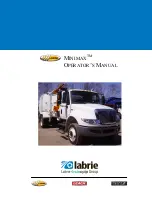
C AB A N D BO DY M O U N T IN G S 1-74
SER VIC E S T A T IO N M E T H O D
The J-8393 Deluxe Portable Air Conditioner
Service Station supplies all evacuating and charg
ing equipment assembled into a compact portable
unit.
1. Be certain compressor hand shut-off valves
are closed to gauge fittings (counterclockwise).
2. Be certain all valves on charging station
are closed.
3. Connect high pressure gauge line (with J-
9459 attached) to compressor high pressure gauge
fitting or to core remover Tool J-22132-01 (if used).
4. Turn high pressure hand shut-off valve one
turn clockwise, and high pressure control (2) one
turn counterclockwise (open). Crack open low pres
sure control (1) and allow refrigerant gas to hiss
from low pressure gauge line for three seconds,
then connect low pressure gauge line to low pres
sure gauge fitting on compressor. Place J-5420
adapter on hose, then attach adapter to gauge fitting
or fitting core remover tool.
Filling Charging Cylinder
1. Open control valve on refrigerant container.
2. Open valve on bottom of charging cylinder
allowing refrigerant to enter cylinder.
3. Bleed charging cylinder to valve (behind
control panel) only as required to allow refriger
ant to enter cylinder. When refrigerant reaches
desired charge level (3-1/4 lbs.), close valve at
bottom of charging cylinder and be certain cylinder
bleed valve is closed securely.
N O T E : While filling the cylinder, it will be
necessary to close the bleed valve periodically to
allow boiling to subside so that refrigerant level
in the charging cylinder can be accurately read.
Charging The System
Using Service Station J-8393
1. With charging station installed as previ
ously described, remove low pressure gauge line
at compressor.
2. Crack open high (No. 2) and low (No. 1)
pressure control valves on station, and allow re
frigerant gas to purge from system. Purge slowly
enough so that oil does not escape from system
along with refrigerant.
3. When refrigerant flow nearly stops, connect
low pressure gauge line to compressor.
4. Turn on vacuum pump and open vacuum con
trol valve (No. 3).
5. With system purged as directed previously,
run pump until 26-28 inches of vacuum is obtained.
Continue to run pump for 15 minutes after the sys
tem reaches 26-28 inches vacuum.
N O T E : In all evacuating procedures, the speci
fication of 26-28 inches of mercury vacuum is used.
These figures are only attainable at or near sea
level. For each 1000 feet above sea level where
this operation is being performed, the specifica
tions should be lowered by 1 inch.
Example: At
5000 ft. elevation, only 21 to 23 inches vacuum can
normally be obtained.
6. If 26-28 inches vacuum (corrected to sea
level) cannot be obtained, close vacuum control
valve (No. 3) and shut off vacuum pump. Open re
frigerant control valve (No. 4) and allow some re
frigerant to enter system. Locate and repair all
leaks.
7. After evacuating for 15 minutes, add 1/ 2
pound of refrigerant to system as described in
step 6 previously. Purge this 1/2 pound and re-
evacuate for 15 to 30 minutes. This second evac
uation is to be certain that as much contamination
is removed from the system as possible.
8. Only after evacuating as directedpreviously
system is ready for charging. Note reading on
sight glass of charging cylinder. K it does not con
tain a sufficient amount for a full charge, fill to the
proper level.
9. Close low pressure valve on charging sta
tion. Fully open station refrigerant control valve
(No. 4) and allow all liquid refrigerant to enter
system. When full charge of refrigerant has enter
ed system (3-1/4 lbs.), turn off refrigerant control
valve (No. 4) and close both hand shut-off valves.
10. If full charge of refrigerant will not enter
system, close high pressure control and refriger
ant control valves. Start engine and run at slow
idle with compressor operating. Crack refrigerant
control valve (No. 4) and low pressure control on
station. Watch low side gauge and keep gauge below
50 psi by regulating refrigerant control valve.
Closing valve will lower pressure. This is to pre
vent liquid refrigerant from reaching the com
pressor while the compressor is operating. When
required charge has entered system, close refrig
erant control valve and close low pressure control.
11. System is now charged and should be per
formance tested before removing gauges.
ADDIN G REFRIGERANT
(S M A L L A M O U N T )
The following procedure should be used in add
ing small amounts of refrigerant that may have
been lost by leaks, or while opening system for
servicing the compressor. Before adding refriger
ant to replace that lost by leaks, check compressor
oil level and add oil if necessary. See "Adding Oil"
later. N O T E : This procedure will only apply if the
air inlet temperature is above 70 °F ., at the con
denser.
1.
Remove caps from compressor gauge fit
tings. Attach gauge set to gauge fittings, making
sure Schrader adapter is between low pressure
gauge hose and suction gauge fitting, and between
high pressure gauge hose and discharge gauge
fitting.
CHEVROLET SERIES 70-80 H EAVY DUTY TRUCK SH O P M A N U A L
Summary of Contents for 70 1969 Series
Page 1: ...CHEVROLET HEAVY DUTY TRUCK SHOP MANUAL...
Page 3: ......
Page 11: ...LUBRICATION 0 4 CHEVROLET SERIES 70 80 HEAVY DUTY TRUCK SHOP MANUAL...
Page 27: ......
Page 119: ......
Page 361: ......
Page 371: ......
Page 427: ......
Page 443: ......
Page 451: ......
Page 493: ......
Page 499: ......
Page 549: ......
Page 555: ......
Page 609: ......
Page 715: ...am...
Page 745: ......
Page 910: ......
Page 913: ......



































